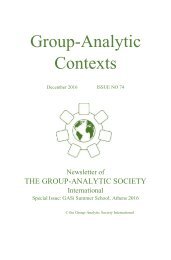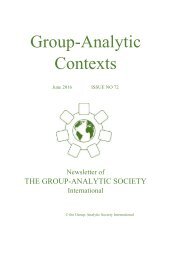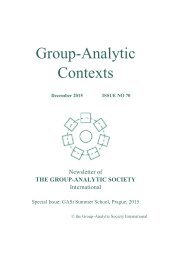Group-Analytic Contexts, Issue 80, June 2018
Create successful ePaper yourself
Turn your PDF publications into a flip-book with our unique Google optimized e-Paper software.
<strong>80</strong> <strong>Group</strong>-<strong>Analytic</strong> Society International - <strong>Contexts</strong><br />
Was it possible to imagine a boundary? Was it a line or an<br />
area? National borders gave shape to a group identity. Who was in<br />
and who was out. The exclusion of some people – and the experiences<br />
they embodied – was inevitable. That fitted in with the therapist’s idea<br />
of group therapy, but it didn’t seem to stack up when the Visitors<br />
asked questions about the nature of an inclusive therapeutic culture.<br />
The group composition had ensured that it had been plunged into<br />
global issues – torn out of any possibility of exclusive suburbs. Did<br />
they not consider risk? This group was dangerous. An attack had been<br />
narrowly prevented – by a terrorist! Everyone had been stirred up.<br />
They were unsettled - but they were connected! And - most people had<br />
tried to support someone - although no one else had intervened as<br />
dramatically as the terrorist and the nurse.<br />
She revisited earlier conversations. What did it mean if<br />
internal boundaries were established in relation to a resilient mother:<br />
a human presence that could ‘stand the strain’? Surely that was<br />
infinitely variable. And some strains were unbearable. How could<br />
such an experience be re-created in a professional setting with<br />
unwilling or impossible clients? It would make professional<br />
guidelines impractical. Could she stand the strain of working with a<br />
violent criminal? She looked at the nurse. Her respect for this brave<br />
woman continued to grow although she doubted whether it was mutual.<br />
She enjoyed the nurse’s spontaneity. There was hardly an<br />
evidence base, or professional guidelines, for intuitive interventions<br />
in chaotic situations. She couldn’t imagine being that unplanned. Even<br />
in the therapy group in which she’d been a patient, she’d been in<br />
training – and was always aware that she wanted to qualify - which<br />
circumscribed her contributions. Had her training institution echoed<br />
her judgemental mother to whom she had ‘bound’ herself despite her<br />
assertions of intellectual independence? Were the ‘boundaries’ she<br />
advocated primarily boundaries in her own mind against her own more<br />
chaotic thoughts and impulses? This was uncomfortable. She steadied<br />
herself - and thereby reorganized her defences, allied with the manager<br />
and distanced herself from the nurse. She doubted whether the nurse<br />
had even had therapy.<br />
Did those who lived near the boundary, on both sides, have<br />
as much in common as those who lived on the same side? Where did<br />
that thought come from? She looked towards the Visitors. When she<br />
looked around, the therapist realized that several group members were<br />
similarly perplexed as to where the random questions that occurred in<br />
their minds were coming from.<br />
Was it the nurse’s deficient grasp of reality that made her













